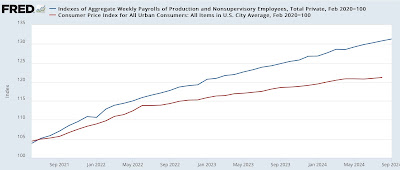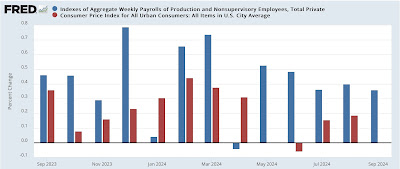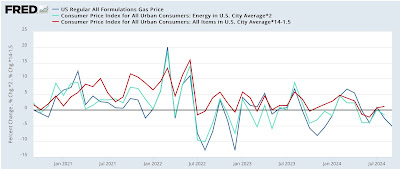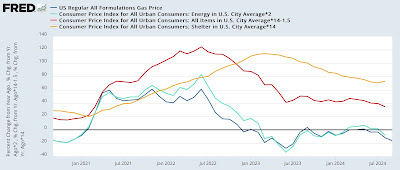Real aggregate payrolls and inflation preview for September – by New Deal democrat Tomorrow consumer prices for September will be reported. It’s almost certain that the best short term forecasting tool from the employment report, real aggregate payrolls, will increase once again. Let’s take a more detailed look. Post-pandemic, nominally aggregate payrolls have increased relentlessly. Consumer prices increased almost as relentlessly until June 2022. Since then payrolls have continued to increase faster than prices (graph below norms both series to 100 just before the onset of the pandemic): Here’s the month by month look for the past year. In all but two of the past twelve months, payrolls increased significantly more than consumer
Topics:
NewDealdemocrat considers the following as important: September 2024, US EConomics
This could be interesting, too:
NewDealdemocrat writes JOLTS revisions from Yesterday’s Report
Bill Haskell writes The North American Automobile Industry Waits for Trump and the Gov. to Act
Bill Haskell writes Families Struggle Paying for Child Care While Working
Joel Eissenberg writes Time for Senate Dems to stand up against Trump/Musk
Real aggregate payrolls and inflation preview for September
– by New Deal democrat
Tomorrow consumer prices for September will be reported. It’s almost certain that the best short term forecasting tool from the employment report, real aggregate payrolls, will increase once again. Let’s take a more detailed look.
Post-pandemic, nominally aggregate payrolls have increased relentlessly. Consumer prices increased almost as relentlessly until June 2022. Since then payrolls have continued to increase faster than prices (graph below norms both series to 100 just before the onset of the pandemic):
Here’s the month by month look for the past year. In all but two of the past twelve months, payrolls increased significantly more than consumer prices – meaning that, consumers had more payroll income, in real terms, available to spend. In September, it is almost certain that trend will continue, with aggregate payrolls increasing 0.4%:
Consumer inflation has mainly been a function of two things: gas and shelter.
In September, gas prices decreased -5.2% (dark blue in the graph below). This typically means a change in the energy component of CPI of about -2.7% (light blue). And since energy is about 7% of the total weighting for CPI, dividing gas prices by 14 gives us a ballpark estimate of total CPI (red), keeping in mind that over time the more stable portions of the average increase about 2% a year:
All else being equal, i would expect CPI tomorrow to be close to unchanged or even down -0.1%.
But as I have discussed ad nauseam for the past several years, the huge house price increases in 2021-22 have translated, with a 12+ month lag, into very large increases int he shelter component of CPI, which is 25% of the entire index. Here’s what the YoY% changes in gas, energy, shelter, and the total index look like post-pandemic:
Shelter inflation has been decelerating for the past 16 months. That should continue tomorrow, as new rents continue to decline slightly YoY as shown by the most recent installment of the Apartment List National Rent Report:
Since many tenant leases are longer than 12 months, CPI has followed suit much more slowly. But the trend of deceleration should continue tomorrow, particularly as last September CPI for rents increased 0.5% for the month. Since then the monthly increases have generally been 0.2%-0.4%.
The bottom line is that September CPI tomorrow is likely to be somewhere between unchanged and 0.2%, and that will mean that once again in real terms consumers had more money to spend in September than ever before. And that means the economic expansion will continue at least for a few more months.





